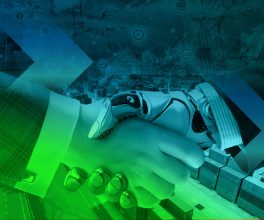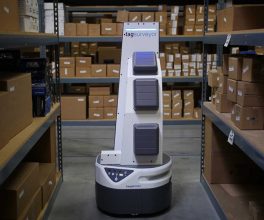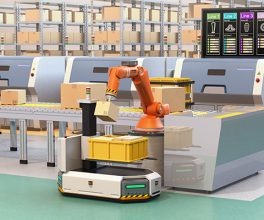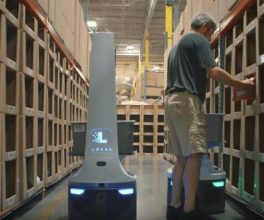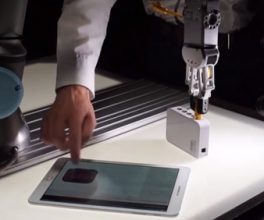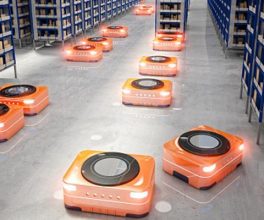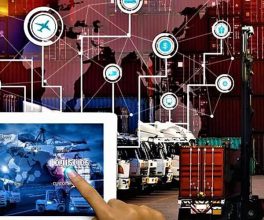Providers of voice solutions see potential for smart glasses as multi-modal devices that can support a combination of voice, vision and scanning. Here’s how smart glasses can be used in DCs as well as where augmented reality technology is headed.
As consumers we constantly hear the hype about technologies like driverless cars and aerial delivery drones, but the reality is few of us have ridden in a fully autonomous vehicle or had a drone hover onto our porch with an e-commerce order. Just where is all this futuristic tech, we may wonder?
In the warehousing world, a similar dynamic is at play with smart glasses. We’ve heard about vision-picking pilots that use smart glasses, but relatively few distribution centers seem to be rolling them out. So when will smart glasses take hold, and how can they help?
While a handful of companies such as DHL have used smart glasses, the mainstay mobile device remains ruggedized handhelds that use radio frequency (RF) technology to communicate with host systems. Change is taking place, however, with glasses technology progressing, and other devices such as smart watches also expanding the range of choices.
“I think there is a lot of interest and experimentation going on with smart glasses, but also unanswered questions from a technology standpoint and also from the user and application standpoints,” says David Krebs, a vice president of research with analyst firm VDC Research. “I think the technical barriers increasingly are being overcome as the hardware progresses. The bigger issues tend to be more from an application standpoint.”
To increase smart glasses use in the warehouse, adds Krebs, vendors and industry participants will need to find applications that make the most of the hardware’s capabilities. “From an application standpoint, you need to consider whether you are just overlaying [smart glasses] over an existing workflow, or really using their capabilities to drive even greater levels of benefit,” he says.
Different capabilities
For smart glasses, much of their appeal is not just in giving visual cues, but also leveraging the voice or bar code scanning capability found in most glasses. Some smart glasses can also use Bluetooth to pair with a rugged ring scanner for more scan-intensive duties.
To fully understand the potential for smart glasses, it’s important to understand the terminology. One distinction, notes Krebs, is that some smart glasses rely on a micro-display or a “heads up display” (HUD) tucked into an edge of the field of view, whereas other smart glasses provide for augmented reality (AR) in which the glasses can overlay translucent visuals right into the field view.
To date, most vision-picking pilots have used HUD-type glasses, though some vendors and companies also have experimented with AR glasses to do things like create “virtual” put walls. AR glasses with autonomous vision recognition enable additional capabilities.
DHL Supply Chain is an early adopter of smart glasses. The third-party logistics (3PL) provider has tested smart glasses at two DCs in the United States and about a half dozen other DCs globally, says Adrian Kumar, vice president of solution design for DHL Supply Chain, North America.
The U.S. pilots focused on unit picking to a cart, using smart glasses with a heads up display, yielding about a 10% productivity improvement over mobile handhelds, thanks mainly to the visual directives glasses provide without manipulating a handheld. “Glasses can give the worker useful visual cues, both for picking and for sorting actions,” says Kumar. “We’ve found they have a very good impact in that type of cluster-pick scenario in which workers need direction both on how to pick and how to sort.”
In testing smart glasses at DHL, the solution has been multi-modal, in that workers give voice confirmations back to the system with the smart glasses and typically use wearable Bluetooth scanners. While smart glasses do offer built-in scanning, wearable ring scanners are better suited to cluster picking to a cart simply because the cart is low to the ground and thus scanning items on the cart would be awkward with glasses alone. DHL is also looking at the potential for smart glasses with AR capability to speed up worker training.
“Smart glasses are in our arsenal of tested, useful technologies,” Kumar says. “They are in our portfolio as an option we can evaluate alongside other options we’ve been testing like robotic picking, or more traditional options like RF handhelds.”
In Europe, multiple 3PLs have piloted vision picking with success. Picavi’s pick-by-vision solution, for example, has been used by 3PLs including Fiege and Geodis, according to Johanna Bellenberg, Picavi’s director of marketing, as well as Klosterfrau Berlin, a German producer of medical products.
The Picavi solution typically incorporates a wearable ring scanner and a wearable power control unit that functions as a battery and control unit for the glasses. Voice directives can be part of a Picavi solution, Bellenberg says. The combination of vision, voice and scanning while keeping the operator’s hands free makes for a productive solution, she adds. Depending on the speed of the previous picking system, Picavi’s customers report time savings of up to 20% using smart glasses.
Voxware has tested smart glasses for multi-modal workflows that can combine visual cues, voice-directed work and some scanning using the glasses.
Multi-mode with voice
Because smart glasses have integrated microphones and speakers, voice solution vendors have been closely involved with them. Voxware, for example, announced support for smart glasses at ProMat in 2017. The company has two customers currently piloting smart glasses from Vuzix as a multi-modal device for Voxware’s Cloud-based voice solution, says Keith Phillips, Voxware president and CEO.
Phillips foresees more customers turning to smart glasses as a device option for warehouse workflows, especially as the hardware technology continues to improve. “Like any new technology for the DC, I think the adoption will be relatively slow, but it will be persistent,” he says, “And, I think it will become pretty prevalent in DCs over the next three to five years.”
For workflows like packing and loading, and returns processing, smart glasses are a good fit because with one device workers can see visual cues, perform voice-directed work, or capture package images or bar code scans. In the pilots Voxware has been involved with, says Phillips, the Vuzix M300 glasses have had enough battery life to last for a shift, and have generally performed well at image capture and scanning.
Phillips says vision picking with smart glasses isn’t necessarily faster than more traditional voice devices for pick-intensive areas of a warehouse, but they can be a good choice when visual cues or pictures of what to pick lend greater clarity to certain tasks, or images of package or product condition need to be taken. “It greatly simplifies the mobile computing environment because now I only have a pair of glasses rather than needing each worker to have multiple devices,” says Phillips.
Over the next 24 to 36 months, Phillips expects smart glass technology to grow at a fast pace, and more glasses vendors are likely to enter the market, leading to more choice and greater confidence among enterprises who want to adopt AR glasses as multi-modal devices. The technical progress is such, adds Phillips, that a key concern in Voxware’s testing has been around issues like user comfort, rather than issues like battery life.
“The real test is how do smart glasses affect the human worker,” Phillips says. “So far, we haven’t come across any significant concerns, but we are evaluating whether smart glasses make for a better work experience.”
Toward AR benefits
Lucas Systems has tested smart glasses as a multi-modal device for its voice-directed solutions and sees potential for the technology, but finds that generally, smart glasses still need to mature on some technical factors, says Krishna Venkatasamy, Lucas Systems’ chief technology officer.
“I think it’s the classic adoption cycle where there is plenty of hype and a lot of interest early on, and everyone is looking for potential to exploit, but the reality is that we have to find the right use cases for the technology, and in the process, the technology itself has to get better,” Venkatasamy says.
Technically, Venkatasamy says, Lucas has found some glasses don’t have enough battery life for a full warehouse shift without using an external battery, or having the worker carrying a hot swappable battery. Additionally, he adds, while you can capture a bar code with smart glasses, for more scan-intensive duties, a Bluetooth ring scanner paired with the glasses offers better performance. And when it comes to speech recognition, the vendor has found that while embedded microphones in the glasses’ frame may offer adequate recognition, accuracy is lower than using a wireless headset with a noise-canceling microphone.
All that said, Venkatasamy says smart glass hardware should progress rapidly over the next couple of years, so concerns around issues like battery life or scanning should diminish. It’s important, he adds, to think about situations in which visual cues from smart glasses can really help an operator, such as when sorting cases onto a pallet, or when picking small, similar items from tight locations. “The use of glasses for broader picking applications is limited right now, but for some specific applications, the use of glasses might be meaningful,” Venkatasamy says.
A major step forward for glasses, Lucas Systems believes, is when AR glasses incorporate vision recognition to provide for better location awareness and another layer of automated task confirmation. For example, an AR system could correctly and quickly recognize which slot to highlight for the next picks.
Chris Bratten, a senior logistics consultant with Bastian Solutions, a warehouse automation solutions provider that has tested AR glasses, agrees autonomous vision is a key capability for expanding what smart glasses can do in a warehouse. Most smart glasses with micro displays use location markers such as bar codes near pick locations so that the glasses can scan a code and “know” where they are and what tasks need to happen, Bratten says.
By contrast, AR or “mixed reality” glasses like Microsoft’s HoloLens use a more robust sensor suite to understand the physical world. “The sensor suite actually looks at the operator’s environment and identifies walls and floors and surfaces, and that means the system can actually be aware of where the operator is in that work space,” Bratten says. “This capability provides an opportunity to give relevant information to an operator, like an arrow pointing them in the right direction.”
Mixed reality glasses with vision recognition, says Bratten, excel at applications like “virtual” put walls or virtual pick-to-light applications. These would use conventional shelving and tap AR to mimic the instructions that lights provide.
The downside of existing AR glasses is that some models aren’t very rugged compared to traditional devices, they have relatively short battery life and may lack other features like removable low-tech parts that can detach from the high-end technology for better hygiene. While AR hardware is evolving quickly, Bratten adds that with mixed reality glasses, the current ruggedness level “is more living room and lab room than warehouse floor.”
Analyze alternatives
The best advice regarding smart glasses for the warehouse is to carefully assess the workflows where they would excel and how they stack up against other device options. These options might include rugged Android devices with touchscreens, as well as devices like smart watches or wrist-mounted rugged devices.
Scott Deutsch, president for North America at Ehrhardt Partner Group (EPG), says EPG has supported smart glasses for three years now for its voice solution, but has yet to find one customer who has decided to implement smart glasses. Recently, one customer considered deploying smart glasses as a multi-modal device for EPG’s voice solution for an area where boxes coming from a conveyor need to be stacked onto pallets, but after analysis, they choose a wrist-mounted, rugged wearable computer that can provide visual cues when needed.
“There are other device choices out there, so consideration of smart glasses should involve a workflow process analysis to see what works best while removing yourself from the hype,” says Deutsch.
Deutsch adds, however, that smart glasses could be a good fit for maintenance technicians in a facility who need hands-free, heads-up access to visual work instructions, but that for general warehouse duties, smart glasses have yet to find that “killer app” that makes them a clear device choice.
Smart watches are another possible option to add visual cues to voice solutions. Lucas Systems, for instance, now supports various smart watches as the main client device for its voice solution. Whereas a couple of years back, smart watches needed to be tethered to another device to add visual cues to a voice system, now several models have enough compute power to serve as the main device for Lucas’s solution, Venkatasamy says. However, smart watches have small screens, so they aren’t well suited to displaying extensive visual information, so their best fit might be as an option for companies coming from legacy, voice-only devices.
For companies that have piloted smart glasses in DCs and found measurable gains, glasses are clearly more than hype. At the same time, the widespread belief is that glasses technology and AR need to evolve a bit more for glasses to begin to make major inroads in DCs.
Jon Liberman, senior director for hardware with supply chain execution software vendor Manhattan Associates, says a couple of customers have piloted vision picking and had some success, but that it remains early days for actual use. The technology is progressing, agrees Liberman, and meanwhile user organizations need to assess “human factors” like eyestrain and the weight and comfort of the newest models. “We are still early days in understanding those human factors,” Liberman says. “I think we are long way from [smart glasses] being mainstream.”
Companies mentioned in this article



